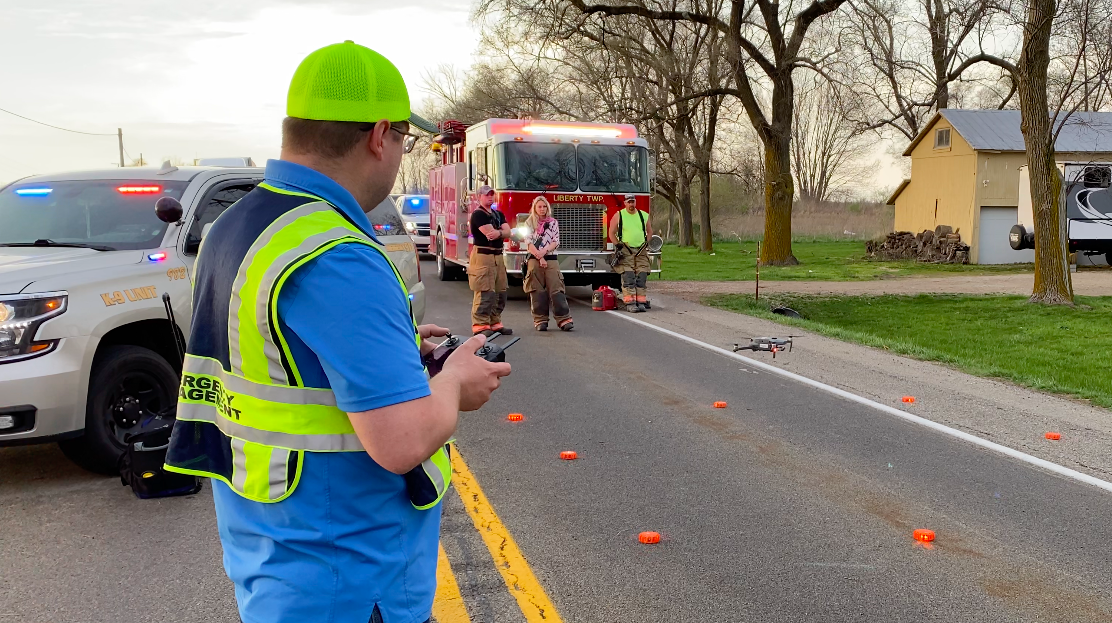Grants fund purchase of drones, training—essential tools for law enforcement
MUNCIE, INDIANA – Mark Carter was tired. But it was a good tired. He’d spent several days in a kind of show-and-tell with Randolph County first-graders, teaching them about unmanned aerial vehicles (drones), why they are important to public safety efforts, and how to operate them.
“They were given information about UAV safety, specifically how high a drone can legally fly, line of sight, and flying over the top of people,” Carter explained.
He was a guest of the Randolph County Extension Office “Day on the Farm” program in October. His demonstration was made possible by a Ball Brothers Foundation grant that purchased the drones for the Purdue Extension Office in neighboring Blackford County.
This year, Ball Brothers Foundation has awarded more than $50,000 to fund the purchase of drones and to create a unique program to train emergency responders on how to use drones in their work.
The grants align with the foundation’s Emergency Management Initiative, designed, in part, to fund special community safety equipment that is not necessarily covered with taxpayer dollars.
“We rely on grants to fund equipment like this,” said Kyle Johnson, Delaware County’s Chief Information Officer. “We do not have equipment funds in our annual budget to draw on, so opportunities like these are what allow us access to industry-standard gear.”
Purdue Extension Blackford County received $45,600 to purchase UAVs and sensors to use as part of its public safety training program. The program is designed specifically for law enforcement officers, firefighters, emergency management professionals and local county officials. Besides using the drones in crime scenes and for police investigations, participants were trained in FAA regulations, law enforcement tactics, fire operations and emergency management applications.
The goal is to fly the drones safely and in controlled airspace.
“It’s been absolutely amazing,” said Carter, Purdue Extension Precision Ag Technology Educator. “When training is complete, operators have had hands-on experience with this equipment. It makes their jobs safer and them more efficient.”
Carter said his office has trained 13 state police, seven city police officers, eight county officers, a half dozen firefighters and five county emergency management people. “This kind of technology is an absolute game-changer,” Carter said. “We can conduct a 10-minute flight at the scene of an accident and have enough information to make an accurate police report and provide information for insurance purposes or to the county prosecutor, if they need it.”
Ultimately, the program’s leaders hope to expand the training statewide to train as many officers as possible.
Delaware County Emergency Management/Homeland Security received grants that supported the purchase of two drones, allowing the team to evaluate and assess hazards while keeping humans out of dangerous situations. As a result of the funding, there are always two drones and two pilots available for 24/7 emergency service. The funding also provided support equipment such as a hard case, spare parts, spare batteries and an iPad for mapping and zoning software.
Drones are often deployed to find missing persons, assist in search of fleeing fugitives, document accident and crime scenes, assist SWAT and criminal surveillance, and investigate homes too dangerous for humans to enter. The new drones are equipped with forward-looking infrared cameras and detect heat signatures of people who otherwise couldn’t been seen at night or in a wooded area, for example. Another use is to send a drone to a hazardous material incident to get a better idea of the hazard without having to send personnel into a potentially dangerous area.
“We have a growing demand for licensed drone pilots and drones themselves,” explained Johnson. “We use them in a variety of ways, but they’ve become essential in documenting an accident scene. In the old days, police would lay down markers and begin the tedious task of reconstructing what happened. A drone allows us to capture pictures that can be pieced together in one big mosaic and do the same thing. It’s the difference of a road being closed three or four hours to only an hour.”
# # #
About Ball Brothers Foundation
Ball Brothers Foundation is one of the state’s oldest and largest family foundations. Annually, the foundation makes approximately $8 million in grants to support arts and culture, education, the environment, health, human services, and public affairs. The Muncie-based private foundation gives priority to projects and programs that improve the quality of life in the foundation’s home city, county, and state.

